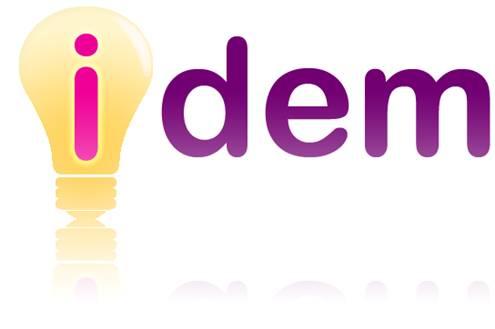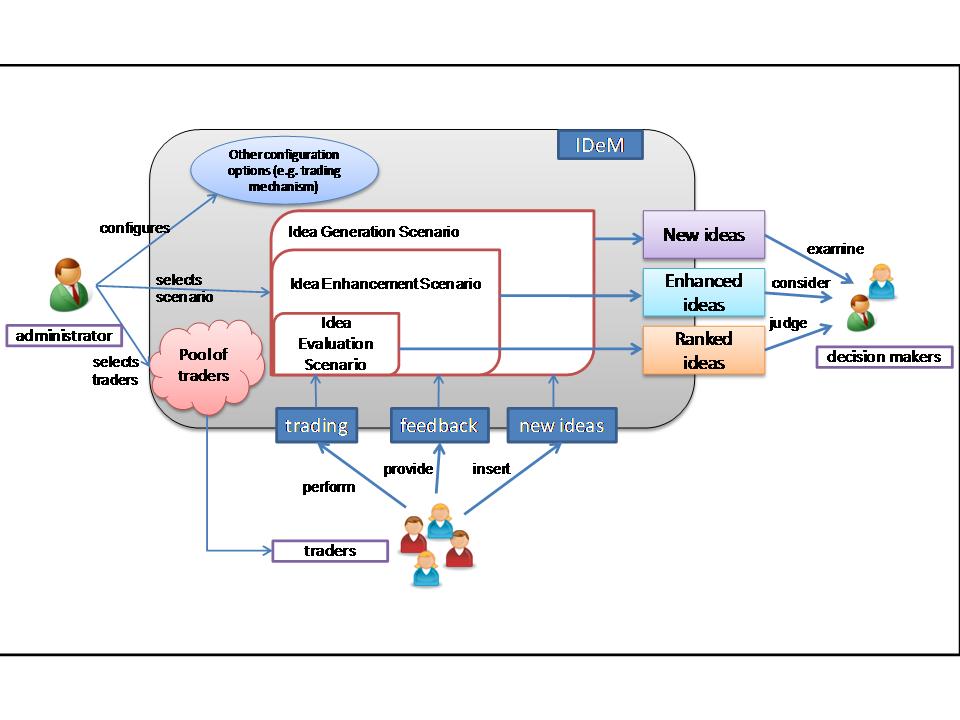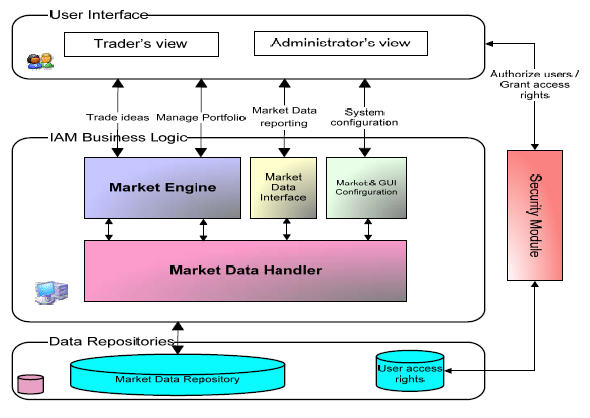
IDEM is an information aggregation market that is especially developed for innovation and idea management. IDEM supports thw whole lifecycle of idea generation and evaluation. IDEM exploits the power of collaborative idea management using Web 2.0 technologies (prediction markets and Wikis).
NEW: Download the IDEM poster !
##Description:
The global build-up of the World Wide Web has made possible that anyone with a computer and Internet access may explore, join, and contribute to any Web community at any time. This new freedom is often attributed to the “Web 2.0 era” of services and applications that let users easily share opinions and resources. Among the various technologies that leverage Web 2.0 “collective intelligence” are Information Aggregation Markets (IAMs). These are virtual stock markets whose purpose is to collect and aggregate information. Participants trade on contracts that represent future events, and upon the market end an index, the price of these virtual stocks, incorporates the available information with respect to that event.
IAMs can be used in the innovation process for harnessing the collective intelligence of users. Although several tools exist for deploying IAMs, none of them corresponds to the particularities of the idea management process. Firstly they do not fully support user feedback, and in most cases user participation is limited to trading. Secondly they are configured to aggregate information regarding well defined future events. When IAMs are utilized for idea management, the underlying contracts are correlated to the potential of success of the ideas. This situation creates uncertainty since some ideas may never be realized and the future event may never happen. The third issue is the limited information they provide as output. Besides market price, analysis of other data such as transactions and user participation may reveal useful information.

These limitations urged us to develop a web–based software tool which we call IDeM. IDeM was designed to facilitate the use of IAMs within companies in the idea management process. When designing it, we took into consideration that such a tool should allow the generation of new ideas and should be able to record feedback from the market participants. Furthermore it should be flexible enough in its configuration options to allow the formation of various usage scenarios, adapted to the needs of different companies. At the same time its code should be easily expandable, its GUI should be motivating, easy to understand and more game like, hiding all the complexity of traditional stock market applications.

###The architecture of IDEM
##Publications:
- Bothos, E., D. Apostolou, G. Mentzas (2007) "Evaluating New Ideas with Prediction Markets, in the workshop "KM – Applications, Methods and Practices", Stream: Knowledge Management, EURO 2007, 22nd European Conference on Operational Research, Prague.
- Bothos, E., D. Apostolou and G. Mentzas (2008) Idea Selection and Information Aggregation Markets, IEEE International Engineering Management Conference , June 28-30, 2008, Estoril, Portugal.
- Bothos, E., D. Apostolou and G. Mentzas (2008) A Collaborative Information Aggregation System for Idea Management, Proceedings of the Third International Conference on Internet and Web Applications and Services, ICIW 2008 , track: ONLINE: Online Communications, Collaborative Systems and Social Networks, June 8-13, Athens, Greece, Page(s):289 – 296, Download the paper .
- Bothos, E., D. Apostolou and G. Mentzas (2008) Collaborative Idea Management with an Information Aggregation System, eChallenges e-2008 Conference , 22 – 24 October 2008, Stockholm, Sweden.
##Videos:
Below you may find some videos which describe the functionality of IDeM:
- [Definition of a new market ] (/sites/default/files/software/create_market.swf)
- Trading
- Feedback
- Market closure
You may also view a presentation of the system.
##Trials:
IDeM has been tested for innovation management within SAP Inspire, the corporate venturing department of SAP . Read a related presentation of SAP .
During July 2008 IDeM has also been tested with an Idea Market in the context of the public consultation "ICT enabling energy efficiency " of the European Commission. The purpose of deploying IDEM in this context was to allow participants to submit and evaluate ideas (potential proposals to the European Commission) in the area of ICT for Energy Efficiency. More than 60 participants traded in a market with 15 ideas.

